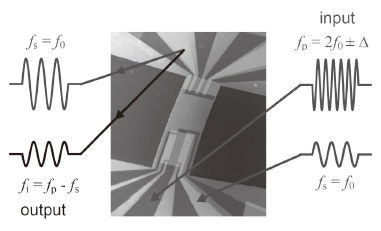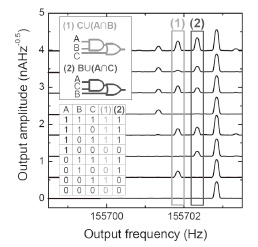Physical Science Laboratory
The pioneering mechanical computer has been largely forgotten with the
advent of Boolean logic, the semiconductor transistor and integrated circuits
which have given rise to logic gates that underpin all modern computation
[1]. However as conventional computers toil to conserve Moore’s law, the
nanoelectromechanical computer was proposed which has acquired urgency
as it offers the tantalizing prospect of low power consumption. In spite
of some recent experimental effort, a universal electromechanical logic
gate based on Boolean algebra has remained beyond reach. To address this,
we realise a practical logic device in an electromechanical resonator operated
in the non-degenerate parametric amplification regime [2, 3].
Widely used in optics, non-degenerate parametric amplifiers can enable
the frequency of a laser to be tuned. Frequency conversion is realised
by exploiting the interaction of an intense high frequency pump beam (fp) with a less intense lower frequency signal beam (fs) in a crystal with a nonlinearity due for example to the Kerr effect which
both amplifies the signal beam as well as generating an idler beam (fi) where this process conserves energy i.e. hfp=hfs + hfi and h is Planck’s constant.
Here we exploit this concept in a tiny mechanical resonator (Fig. 1) where
multiple channels of binary information are encoded via the pump as nanometre
scale oscillations at different frequencies. The parametrically activated
nonlinearity in the mechanical resonator can mix the input binary channels
resulting in a rich idler spectrum of output oscillation states that can
be used to not only construct all the primary logic gates and multi-bit
logic circuits (Fig. 2) but also to execute Boolean logic functions in
parallel all in just a single mechanical oscillator. These results suggest
that a nanomechanical computer based on these ground breaking techniques
could have potentially unrivalled data processing power.
[1] http://www.sciencemuseum.org.uk/onlinestuff/stories/babbage.aspx
[2] I. Mahboob et al., Nature Commun. 2 (2011) 198.
[3] I. Mahboob et al., Appl. Phys. Lett. 97 (2010) 253105.
 |
 |
|||||
|
|